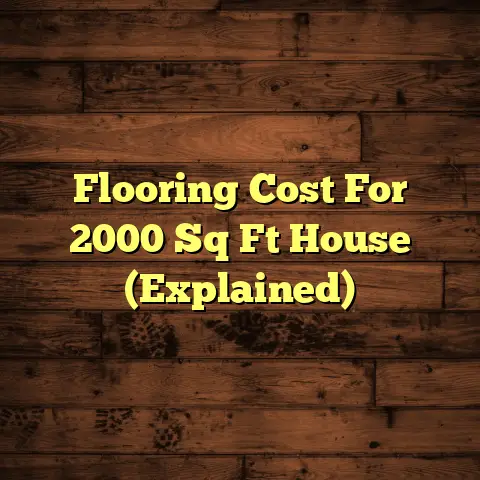Room Square Footage: Measure Right! (1 Mistake Costs!)
The culprit might be something you overlooked: inaccurate room measurements.
It’s more than just aesthetics; accurate square footage plays a vital role in everything from noise reduction to energy efficiency and overall comfort. I’ve seen it time and again in my years as a flooring contractor.
Let’s dive into the nitty-gritty of room square footage, why getting it right matters, and how to avoid costly mistakes. Trust me, a little extra effort here can save you a lot of headaches (and money) down the road.
Noise Reduction and Square Footage:
The Unlikely Duo
Okay, let’s get a bit nerdy for a second. Think of your room as a sound chamber. The larger the space, the more sound waves bounce around. This can lead to echoes and a general sense of noise pollution, especially in rooms with hard surfaces like tile or hardwood.
Square footage directly impacts sound reflection and absorption. A smaller room might feel “boomy” if it’s not properly treated, while a larger room might feel echoey and empty. This is where the right flooring and furnishings come in.
For example, a plush carpet in a smaller room can absorb a lot of sound, creating a more intimate and comfortable atmosphere. Conversely, in a large, open living room, strategically placed rugs, curtains, and upholstered furniture can help break up sound waves and reduce echo.
Have you ever walked into a restaurant and felt overwhelmed by the noise? Chances are, it’s a combination of poor acoustics and a large, open space. The same principle applies to your home.
Accurate measurements are the first step in creating a more acoustically balanced environment. You need to know the true dimensions of your space to make informed decisions about flooring, wall coverings, and furniture.
The Thesis: Accuracy Matters
So, here’s the deal: accurate room measurements aren’t just about making sure your new sofa fits. They’re about creating a functional, comfortable, and aesthetically pleasing living space.
From reducing noise pollution to optimizing energy efficiency and maximizing your investment, precise measurements are crucial. Let’s explore the world of room square footage and learn how to measure like a pro!
Section 1: Understanding Room Square Footage
What is Square Footage?
In simple terms, square footage is the area of a room or space, expressed in square feet. It’s calculated by multiplying the length of the room by its width. This measurement is fundamental in real estate, interior design, and home improvement.
Think about it: when you’re buying a house, one of the first things you look at is the square footage. It gives you a sense of the size and potential of the property. Similarly, when you’re planning a renovation project, square footage is essential for estimating material costs and labor.
The Formula: Length x Width = Square Footage
The basic formula is straightforward:
- Square Footage = Length x Width
But don’t let the simplicity fool you. Accuracy is key. Even a small error in your measurements can lead to significant discrepancies in the final square footage calculation.
For example, let’s say you’re measuring a rectangular room that’s 12 feet long and 10 feet wide. The square footage would be:
- 12 feet x 10 feet = 120 square feet
Seems easy enough, right? But what happens when the room isn’t perfectly rectangular? Or when there are built-ins or closets to consider? We’ll get to that in Section 2.
Usable vs. Total Square Footage: Know the Difference
Here’s another critical distinction: usable square footage vs. total square footage.
-
Total square footage includes all the space within the walls of a room, regardless of whether it’s actually usable.
-
Usable square footage refers to the space that you can actually use for living or storage.
Why does this matter? Well, imagine you’re measuring a room with a large, built-in closet. The total square footage might be 200 square feet, but the usable square footage might be closer to 180 square feet, depending on the size of the closet.
When calculating material needs for flooring or paint, it’s crucial to use the usable square footage. Otherwise, you might end up overbuying materials and wasting money. I’ve seen homeowners make this mistake countless times.
Section 2: Common Measurement Mistakes
Okay, let’s talk about the blunders I’ve witnessed over the years. Measuring a room seems simple, but it’s surprisingly easy to mess up. Here are some of the most common mistakes I see:
1. Skipping Corners and Irregular Shapes
Irregularly shaped rooms are the bane of my existence. They’re common in older homes, and they can be a real challenge to measure accurately.
The biggest mistake people make is trying to measure the room as a single rectangle or square. This simply doesn’t work. Instead, you need to break the room down into smaller, more manageable shapes.
For example, if you have an L-shaped room, measure each section separately and then add the square footage together. If you have a curved wall, try to approximate it as a series of straight lines.
Pro Tip: Sketch the room on a piece of paper and label each section. This will help you keep track of your measurements and avoid confusion.
2. Ignoring Built-Ins and Architectural Features
Built-ins, closets, and other architectural features can significantly impact the usable square footage of a room. Failing to account for these features can lead to serious errors in your calculations.
For example, if you’re installing new flooring, you’ll need to deduct the square footage of any built-in cabinets or shelving units. Similarly, if you’re painting the walls, you’ll need to subtract the area of any large windows or doorways.
Real-Life Example: I once had a client who ordered too much hardwood flooring because they forgot to account for a large, built-in bookcase. They ended up with an extra 50 square feet of flooring that they couldn’t return. That’s a costly mistake!
3. Measuring at the Wrong Height or Ignoring Ceiling Height
This one is a bit less obvious, but it’s still important. When measuring a room, you need to make sure you’re measuring at the correct height.
For example, if you’re measuring for wallpaper, you’ll need to measure the height of the walls in addition to the length and width of the room. Similarly, if you’re installing crown molding, you’ll need to consider the ceiling height.
Ceiling height can also impact the overall feel of a room. A room with high ceilings will feel more spacious and airy, while a room with low ceilings might feel cramped and claustrophobic.
Pro Tip: Use a laser distance measurer to accurately measure ceiling height. These tools are relatively inexpensive and can save you a lot of time and effort.
4. Rounding Errors: A Penny Saved is a Fortune Lost
We all love to round numbers to make things easier, but rounding errors can add up quickly when you’re measuring square footage.
For example, if you’re measuring a room that’s 10.5 feet long and 12.2 feet wide, rounding those numbers down to 10 feet and 12 feet could result in a significant underestimation of the square footage.
Instead of rounding, try to be as precise as possible. Use a tape measure with clear markings and record your measurements to the nearest inch. Then, use a calculator to perform the calculations.
Section 3: The Cost of Inaccurate Measurements
Alright, let’s talk about money. Inaccurate measurements can cost you a lot of it. I’ve seen it happen time and time again. Here are some of the financial implications of measuring mistakes:
1. Overpaying for Flooring or Paint
This is probably the most common consequence of inaccurate measurements. If you overestimate the square footage of a room, you’ll end up buying more flooring or paint than you actually need.
Let’s say you’re installing hardwood flooring in a room that you think is 200 square feet. You buy enough flooring to cover 200 square feet, but it turns out the room is only 180 square feet. You’ve just wasted money on 20 square feet of flooring that you don’t need.
The Cost: Depending on the type of flooring you’re using, that extra 20 square feet could cost you hundreds of dollars. And don’t forget about the cost of disposal!
2. Underestimating Material Needs
The opposite problem is just as bad. If you underestimate the square footage of a room, you’ll end up buying too little flooring or paint. This can lead to project delays and increased costs.
Imagine you’re painting a room that you think is 150 square feet. You buy enough paint to cover 150 square feet, but it turns out the room is actually 170 square feet. You’ll have to make another trip to the store to buy more paint, which will cost you time and money.
The Cost: Not only will you have to pay for the additional materials, but you’ll also have to factor in the cost of the extra trip to the store. And if you’re hiring a contractor, you might have to pay them extra for the delay.
3. Impact on Property Value
Inaccurate square footage can also impact the value of your property. When you’re selling your home, potential buyers will want to know the square footage. If you overestimate the square footage, you could be accused of misrepresentation. If you underestimate the square footage, you could be leaving money on the table.
According to a report by the National Association of Realtors, square footage is one of the most important factors that buyers consider when purchasing a home. A small error in square footage can have a big impact on the perceived value of your property.
The Cost: Depending on the market, a difference of even 50 square feet could affect your home’s selling price by thousands of dollars.
Case Study: The $10,000 Mistake
I once worked with a client who was selling their home. They had measured the square footage themselves and listed the property as 2,000 square feet. However, when the buyer had the property appraised, it turned out to be only 1,950 square feet.
The buyer used this discrepancy to negotiate a lower price. My client ended up having to reduce the price of the home by $10,000 to close the deal. All because of a simple measuring mistake!
Section 4: Tools and Techniques for Accurate Measurement
Okay, so how do you avoid these costly mistakes? The key is to use the right tools and techniques. Here’s a rundown of the best options:
1. Tape Measures
The humble tape measure is still the workhorse of the measuring world. It’s inexpensive, easy to use, and relatively accurate.
Pros:
- Affordable
- Portable
- Easy to read
Cons:
- Can be difficult to use in tight spaces
- Requires two people for long measurements
- Prone to errors if not used correctly
Pro Tip: Invest in a high-quality tape measure with clear markings and a sturdy housing. Look for a tape measure that’s at least 25 feet long.
2. Laser Distance Measurers
Laser distance measurers are a game-changer. They use a laser beam to measure distances quickly and accurately.
Pros:
- Extremely accurate
- Easy to use
- Can measure long distances with one person
Cons:
- More expensive than tape measures
- Can be affected by bright sunlight
- Requires batteries
Pro Tip: Laser distance measurers are especially useful for measuring ceiling height and irregularly shaped rooms.
3. Mobile Apps
There are a number of mobile apps that can help you measure room square footage. Some of these apps use the camera on your smartphone to create a 3D model of the room, while others allow you to manually enter measurements.
Pros:
- Convenient
- Can save measurements digitally
- Some apps offer advanced features like 3D modeling
Cons:
- Accuracy can vary depending on the app
- Requires a smartphone or tablet
- Can be difficult to use in low light
Pro Tip: Experiment with different apps to find one that you like. Read reviews and check the accuracy ratings before you commit to using an app.
Step-by-Step Guide to Measuring a Room
Here’s a step-by-step guide to measuring a room accurately:
- Gather your tools: You’ll need a tape measure, a laser distance measurer (optional), a notepad, and a pen.
- Sketch the room: Draw a rough sketch of the room on your notepad. Label each wall and any architectural features.
- Measure the length and width: Use the tape measure or laser distance measurer to measure the length and width of the room. Record your measurements to the nearest inch.
- Measure any irregular shapes: If the room has any irregular shapes, break them down into smaller, more manageable sections. Measure each section separately.
- Account for built-ins: Measure the dimensions of any built-in cabinets, shelving units, or other architectural features. Subtract these areas from the total square footage.
- Calculate the square footage: Use the formula (Length x Width = Square Footage) to calculate the square footage of each section of the room. Add the square footage of all the sections together to get the total square footage.
- Double-check your measurements: It’s always a good idea to double-check your measurements to make sure you haven’t made any mistakes.
Section 5: Real-Life Applications
Okay, let’s see how accurate measurements play out in the real world:
1. Renovation Projects
Accurate measurements are essential for any renovation project. Whether you’re installing new flooring, painting the walls, or remodeling the kitchen, you need to know the exact dimensions of the space you’re working with.
Example: I once had a client who was remodeling their bathroom. They had ordered new tiles based on inaccurate measurements, and the tiles didn’t fit properly. They had to reorder the tiles, which delayed the project by several weeks.
2. Furniture Placement
Accurate measurements are also important for furniture placement. You need to know the dimensions of your furniture and the dimensions of your room to make sure everything fits properly.
Example: Have you ever bought a new sofa only to discover that it’s too big for your living room? That’s why it’s so important to measure your furniture and your room before you make a purchase.
3. Home Staging and Real Estate Listings
If you’re selling your home, accurate square footage is crucial for attracting potential buyers. As I mentioned earlier, square footage is one of the most important factors that buyers consider when purchasing a home.
Example: A real estate agent friend of mine always emphasizes the importance of accurate measurements when listing a property. She says that it can make or break a sale.
4. Interior Design and Space Planning
Interior designers rely on accurate measurements to create functional and aesthetically pleasing spaces. They need to know the dimensions of the room, the dimensions of the furniture, and the location of any architectural features.
Example: An interior designer I know uses laser distance measurers to create detailed floor plans of her clients’ homes. These floor plans help her visualize the space and plan the layout of the furniture.
Conclusion
So, there you have it. Accurate room measurements are essential for everything from noise reduction to energy efficiency and overall quality of living.
Taking the time to measure correctly can save you a lot of headaches (and money) down the road. Use the tools and techniques mentioned in this article to improve the outcomes of your own projects.
Remember, a little extra effort upfront can make a big difference in the long run. Don’t let a simple measuring mistake cost you time, money, and peace of mind.
Go forth and measure with confidence! Your wallet (and your ears) will thank you for it.





